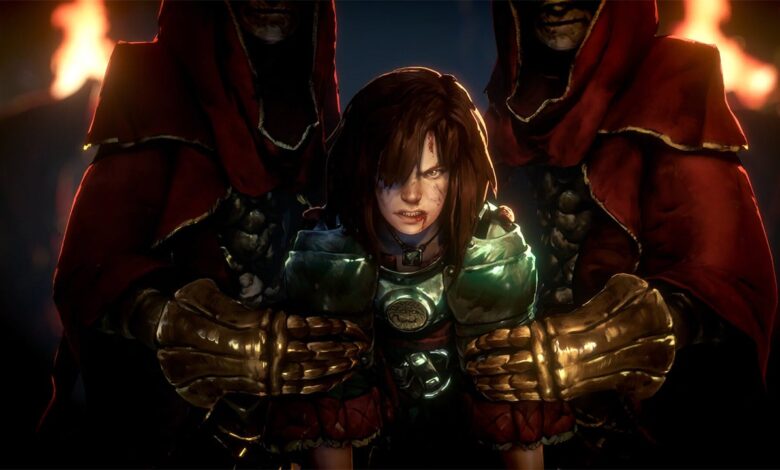No Rest for the Wicked Early Access Review

In its early access state, No Rest of the Wicked is already full of surprises. Mostly those are great, like how one moment I found myself marveling at its slow and precise combat (all but unprecedented in the action RPG genre) and the next I found myself decorating my home like I was in an M-rated Animal Crossing. On the other side, although it’s certainly to be expected from a game that’s clearly labeled as unfinished, there were also some not-so-fun surprises, like various technical issues, a loot and inventory management system that needs some serious tweaking, and some levels that can be a headache to navigate from an isometric perspective. There’s nothing there that feels unsolvable, though, and all of those problems are eclipsed by just how exciting and special this genre-blending pioneer felt throughout my 30+ hours with the content that’s already available.
The setting doesn’t rock the boat too much: You play as a magically imbued warrior and generic chosen one, sworn to fight back an ancient plague that seems to be a pretty serious problem for folks, since they absolutely cannot stop transforming into Lovecraftian horrors at every opportunity. After arriving in the land of Sacra by boat, you immediately set to the task of helping these poor souls out by slaughtering all manner of ghoulish, feral wildlife, infected humans, and murderous bandits, all while suspiciously side-eyeing the zealous, militant church that will almost definitely become the bad guys in the back half of the campaign. It’s not exactly a peachy world to explore, but the compelling characters with top-notch voice performances and depressing vibes of a beautiful world gone terribly wrong are both exceedingly well done and quickly become an extremely alluring reason to press on through each harrowing area and lethal boss. As of now, this story is cut short 10 hours in, just as things are getting interesting, so time will tell if it delivers on that front. So far, though, it’s off to a very strong start.
It definitely helps that No Rest for the Wicked is quite easy on the eyes at nearly every moment, owing to its painterly art style, expressive and memorable characters, and gobsmackingly beautiful foliage. Man, oh, man does Moon Studios sure know what it’s doing when it comes to plants – clearly that experience working on the Blind Forest that Ori enjoys jumping around in has been put to phenomenal use. I will say, though, that at first glance the bizarre humans can be a bit off putting, with their creepily disproportionate, gorilla-like limbs, especially when you jump into the character creator and immediately see a default that looks like a waxed sasquatch. But once I hopped into the world and saw how it fit in with the stylized art, I was quickly put at ease with how I looked from a bird’s eye view.
When you jump into the character creator you immediately see a default that looks like a waxed sasquatch.
Combat sets itself apart as much as the art style, as this divergent action-RPG takes the brisk skirmishes of Diablo or Path of Exile (where you’re triggering a cascade of powerful abilities to kill hundreds of enemies in seconds) and replaces them with steady, methodical, and wonderfully deadly swordplay against small numbers of opponents. Instead of running around as a god of the battlefield, you’re a squishy adventurer who will have to master dodge rolls, perfect parries, and the rare combat ability here and there to scrape by, which makes battles much more challenging and demanding of your full attention. We’re not racing back to our corpses to recover lost loot or working with a finite number of healing items or anything like that, but there’s still plenty of difficulty for us masochists to enjoy. That fresh take on the genre works incredibly well, making for a journey that starts out as much more challenging than most, and where every downed opponent feels like a victory just barely snatched from the jaws of defeat. For someone who’s delved all of Diablo 4’s dungeons already, that’s a lot more engaging than mindlessly plowing through armies with ease (though that can be a lot of fun too).
Exploring the early access portion of the land of Sacra makes for an extremely enjoyable time, whether you’re wading into rotting sewers filled with bandits or navigating ancient ruins where one false step will send you plummeting to your death (even if some of those spills are annoying). There’s an impressive number of enemy types packed into the small number of areas currently available, from diseased, split-faced rats to slimy, four-legged aliens who multiply when killed, and flying witches who teleport around the map and lob fireballs at you.
You’re given plenty of reasons to revisit areas and dig into every nook and cranny.
On top of that, there are lots of secrets to discover and hidden loot to claim, a surprising amount of things to climb, leap to, or precariously balance across that aren’t usually present in isometric level designs, and some really clever shortcuts that allow you to quickly get back to Sacra’s one and only safe haven, located in the center of the map, you’re given plenty of reasons to revisit areas and dig into every nook and cranny. The only issue is that, because you can’t move the camera as you explore, sometimes the fixed view makes it a little hard to tell what can be climbed on, or to understand the exact dimensions of any given narrow walkway you’re maneuvering through. That caused me to accidentally leap to my death on more than one occasion.
The RPG mechanics are similarly inspired, allowing for a ton of customization without locking you into a specific subclass or role that dictates your playstyle (at least initially). Since your build is largely determined by the weapons and armor you bring into battle, each of which comes with their own attacks, abilities, and stats, you get a nice layer of RPG mechanics to mess around with however you like. In one stretch I played as a lightly armored assassin with dual daggers that applied an elemental burn; later I switched to a katana and a shield that healed me as I blocked attacks. The buildcrafting is quite in-depth, and there are already so many combinations I had a hard time picking any one and running with it. That’s a good problem to have!
No Rest for the Wicked – March 2024 Screenshots
Unfortunately, which options are available are limited by how the RNG Gods treat you, since you won’t always get a decent weapon that aligns with how you want to play. Even worse, you might find a weapon you really like but not have the right stats to wield it, and since there’s currently no way to respec, you’ll eventually lock yourself into a certain kind of loadout playstyle and find all other loot basically useless, unless you’re willing to spend attribute points inefficiently just to change styles. For example, I started finding really great two-handed claymores that required lots of strength to use long after I’d committed all my skill points to dexterity. Theoretically you could hand this loot off to your other characters or to fellow players once co-op multiplayer is added, but most of the time it feels like a real bummer to get cool loot you can’t use. That can really pump the brakes on the fun of experimenting with different loadouts, especially after you’ve been playing awhile.
That’s not the only way in which loot can be unkind, either. No Rest for the Wicked falls prey to one of my biggest action-RPG pet peeves: a small inventory that constantly needs to be managed. Loot drops constantly, and even though your carrying capacities can be upgraded little by little, doing so is a slow process and you don’t gain access to real storage options until hours into the adventure, by which time I’d been forced to sell or abandon dozens of items I’d rather have kept. And since there are tons of different materials needed to level up, enchant, and craft weapons, you’re constantly being told to store up stuff you absolutely don’t have room to carry, which creates an infuriating dilemma.
Which options are available are limited by how the RNG Gods treat you.
That kind of thing might work in a game like Baldur’s Gate 3, where something has to stop you from looting every dinner plate you come across (and you have the option to trudge back to camp if you simply refuse to drop your prizes) but here it just doesn’t feel good to pause exploration every couple of minutes to juggle items in my inventory and make gut-wrenching decisions about what to leave behind.
You’ll also find yourself bogged down by the weird way in which healing items are handled. You have to craft them all from raw materials, and they aren’t replenished when you die. This means that if you encounter a particularly tricky part where you’re using lots of healing items and dying a lot, you’ll need to stop what you’re doing, retrace your steps through old areas to harvest herbs and mushrooms, then craft more potions before returning to whichever part was giving you trouble. And if you happen to take damage as you’re foraging and need to use healing items while making these supply runs, you’ll set yourself back even more. (Even Bloodborne’s biggest fans will usually admit restocking health vials is the worst part of it.) It would probably be a better idea to just make healing items more accessible, or make some of them replenish upon death, because it’s always an annoying chore to get through before I can get back to the task of avenging my most recent death.
TieGuyTravis’ Favorite Isometric Action Games
When you aren’t fighting diseased abominations and stuffing baubles into your cute little fanny pack-sized inventory, you’ll find yourself in the cozy town of Sacrament where the goal surprisingly shifts to rebuilding the place, like you suddenly stepped into a Stardew Valley for goth kids. By bringing back materials to invest in the refurbishing of various local establishments and infrastructure you can turn the place into a veritable oasis of friendly vendors and scenic views, from a warm tavern and diner you can build near the town’s entrance, to an elevator in the center that can quickly ferry you from lowtown to the fancy upper level and back again. You can even purchase property for yourself, then spend way too much time decorating your place and filling it with the loot you don’t have room to carry. It’s very weird to find any of this stuff in such a dark, action-packed crusade, but this ended up being one of my favorite aspects. Every piece of wood or ore harvested from the world could be used to build a new facility, or to upgrade a vendor to expand their inventory and make life a bit easier. Plus, it’s just nice to take a break from the monstrosities trying to chop your head off to chill in your house and craft some furniture. Resting, if you will.
The goal surprisingly shifts to rebuilding, like you suddenly stepped into a Stardew Valley for goth kids.
Once you beat the campaign, you’ll unlock a roguelike endgame activity that pits you against a dungeon filled with powerful enemies and enormous amounts of loot (assuming you have inventory space for it). This mode is a lot of fun and makes the early access version of No Rest for the Wicked feel much more substantial. Unfortunately, every run at this activity requires a consumable that you have to grind to earn, and because you’ll likely be using lots of healing items during runs as well, you’ll more than likely have to stop whatever you’re doing to grind out areas you’ve already explored to stock up on items you’ll need to power your future attempts. Between that and juggling my inventory, I found myself spending an awful lot of time staring at menus instead of practicing my perfect parry.
Another caveat is that, while it might be unsurprising for an early access game (or heck, a lot of full launches these days), No Rest for the Wicked has performance and tech issues to iron out. The frame rate is known to dip no matter how powerful your PC is (as evidenced by my own Ryzen 9 and RTX 4090), your character can get stuck in the side of a cliff until you spend some time dodge-rolling to break free, and sometimes massive parts of the environment (like a bridge or part of the ground) are invisible when you approach them until they awkwardly pop into existence right in front of you. Or sometimes they appear to be there when they aren’t: One time I dodge-rolled away from an enemy and went straight through the ground to die in the empty space below. But again, these are the sorts of things one would expect to encounter in early access and then watch as they’re ironed out as development continues, and none of them were such a big deal that I wanted to stop and play something else. Except falling through the map – that’s never fun.
It’s also important to note one of the major things unavailable in this version of No Rest for the Wicked: multiplayer of any type. While this is the very first thing listed on the roadmap of things Moon plans to roll out, its absence is acutely felt by those who, like me, really look forward to playing a game like this with friends. It’ll also be interesting to see how much the balance of combat is altered by adding allies to the mix, because right now the whole campaign feels very specifically tuned for solo play – I almost can’t imagine what a multiplayer version of these quests would feel like. But I’m intrigued to find out!
Verdict
No Rest for the Wicked is a compelling and unique action-RPG that blends a whole bunch of great genre ideas into one promising package, even though its incompleteness can be felt throughout the abridged early access version’s story. With lots of loot and inventory shortcomings, some technical issues, and some isometric camera angles that take getting used to, there’s still plenty to tweak in the months of development to come before 1.0. I, for one, hope the balance of inventory management and grinding health items tips back more in favor of getting you into the action of its skill-based combat. But even in this early state – before co-op multiplayer even arrives – I’ve had an absolute blast with the precise and challenging combat, memorable exploration, and art, voice acting, and characters that make me really eager to see more of the story and further explore the high-risk, high-reward roguelike mode. With so much going for it already, I could easily see this becoming a landmark game for action RPGs, and that potential is exciting.

